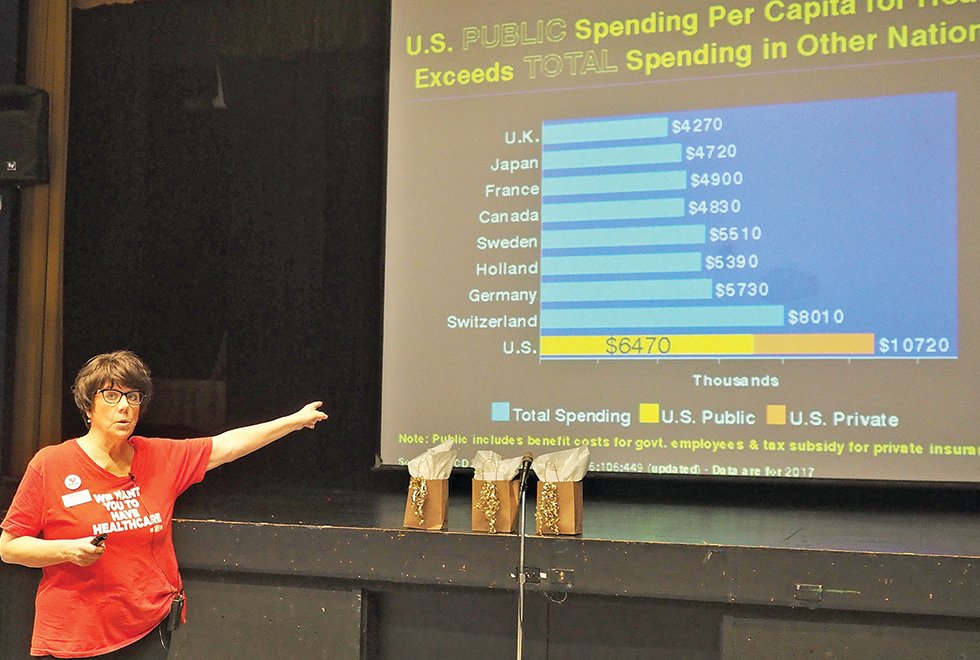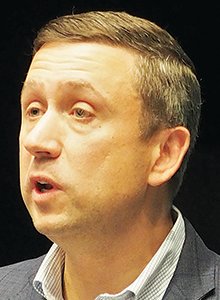Support the Timberjay by making a donation.
DFL forum highlights top issues
ELY – Unity and civility were key themes at Democratic Values in Action: A Northern Minnesota Issues Forum held at Vermilion Community College on Oct. 12. Over 80 area residents came out for an …
This item is available in full to subscribers.
Attention subscribers
To continue reading, you will need to either log in to your subscriber account, below, or purchase a new subscription.
Please log in to continue |
DFL forum highlights top issues

ELY – Unity and civility were key themes at Democratic Values in Action: A Northern Minnesota Issues Forum held at Vermilion Community College on Oct. 12. Over 80 area residents came out for an afternoon packed with presentations focusing on economic inequality, healthcare, and climate change.
The event was sponsored by the North of the Divide DFL and the Outreach Committee of St. Louis County DFL Third District Organizing Unit and was the first in a series of forums planned for the area.
“We need to be having these conversations all over Minnesota and the country,” said State DFL Chair Ken Martin, who opened the event.
Martin outlined the three requirements for a responsible democracy: good ideas, grassroots movements to support those ideas, and engagement in electoral politics.
“If people are cynical and don’t vote, the same people stay in power. If more people participate, we have better government,” Martin said.
According to Martin, voter turnout fell in the 2016 election, especially among segments of the population who had usually been reliable Democratic voters.
“Ten percent of formerly consistent Democratic voters stayed home in 2016,” he said.
Climate Change: Most Critical Issue of Our Time
Presenter Dr. Barbara Jones, of Ely, talked of the many ways that climate change is likely to impact northern Minnesota. Jones, a retired physicist from the University of California, San Diego, presented data showing the acceleration of global temperatures from a baseline recorded between 1850 and 1900. The data showed the temperatures beginning to rise gradually in 1910, then more rapidly around 1980.
According to Jones, climate change is hastening the spread of diseases like West Nile virus and Lyme disease to the north, and is likely to result in a loss in bird species, including the common loon.
Jones spoke about a series of new bills aimed at addressing the impact of climate change, that were passed in the Minnesota House during last year’s session but failed in the Republican-controlled Minnesota Senate. These proposals included a plan to put solar panels on K-12 school roofs and in state parks, as well as the purchase of electric buses for Metro Transit.
Jones said that changes need to take place on both a societal and global level. She stated that this includes developed nations providing increased support to developing nations. She then ended with a list of actions that individuals can take “right now” to help quell the impacts of climate change. This list included having fewer children, installing solar and wind power, avoiding flying when possible, and increasing efficiency in homes.
“Talk to your family, friends, church, neighbors about climate change,” Jones said. “Lobby your political reps for good regional and national policies.”
Patients Over Profits
Rose Roach, Executive Director of the Minnesota Nurses Association said nurses are finished trying to “tweak the edges” when it comes to healthcare.
“It’s time to have a healthcare system that focuses on the patient, not profit,” Roach said.
She argued that employers as well as employees are being “ripped off” by the high administrative costs involved in the current health insurance system.
“It’s a tool used in class warfare,” she stated. “The corporations are stealing our wealth through increases in the cost of health insurance.”
Rose pointed out that life expectancy in the United States has dropped three years in a row due to cost barriers including under-insurance, high deductibles and co-pays, lack of coverage of out-of-network care, and the need for prior authorization of care. People are rationing drugs because of cost, and the working poor are depending on Medicaid.
Roach also spoke about the social determinants of health that need to be addressed, saying, “Poverty, racism, immigration status, and lack of access to affordable housing all drive health outcomes.”
According to Roach, the Minnesota Nurses Association favors a universal single-payer system. Conversion to this plan would include a transition period that would set aside money for individuals currently working in the private insurance industry. Roach also believes there is a need to protect the current Affordable Care Act and that it would be beneficial to build on it and further it.
“It will take political will and political courage to fulfill the goal of a healthcare system that focuses on patients over profit,” said Roach.
Gilded Age Levels of Inequality
World Bank economist Kris Hallberg, of Ely, was next on the agenda, and she provided a well-documented case for the existence of an increased gap between the rich and poor, both in the United States and abroad.
Hallberg demonstrated that the lower levels of inequality that had persisted in the United States since 1940 started to rise in 1980. They then grew until they exceeded the level they were at prior to the Great Depression until reaching the height of the “Gilded Age” of the late 19th Century.
According to Hallberg, wage inequality has continued to increase, with a widening gap between college graduates and those with only a high school education. Whereas several decades ago a cardiologist would only earn four times the wages of a nurse, the same physician would now earn at least seven times the wages of a nurse.
Hallberg made a distinction between one’s actual level of income and the level of inequality in a society. Poverty levels in most of the world have decreased markedly in recent decades, but the unequal distribution of income and wealth has increased. And the levels of inequality in wealth, or the assets that a person holds, have increased more rapidly than wage inequality.
Hallberg claims the reasons for increasing inequality include increasingly regressive income taxes, financial sector deregulation, increasing displacement of workers by technology, globalization, and the decline of labor unions.
“In the 1950s, one-third of workers were in a labor union and now it’s only eleven percent,” said Hallberg. “Forty percent of public sector workers today are unionized, but only five percent of private sector workers.”
According to Hallberg, there are important consequences to the high level of inequality we’re experiencing today, including polarization, social fragmentation, a loss of confidence in institutions, and a lack of social cohesion. She claims the pattern of the distribution of inequality has contributed to an increasing sense of people living in separate worlds.
“Median household income in Democratic districts has gone up while median income has gone down in Republican districts,” Hallberg stated.
She also mentioned that there is a big divide between urban versus rural districts, educated versus less-educated districts, and diverse versus more homogeneous districts.
Hallberg suggested a return to a more progressive tax structure as a way to narrow the income gap.
“We can return to a marginal rate of seventy percent without creating a disincentive to work,” she said.
Hallberg also pointed out the need for policies that focus on the poor and middle class. She believes policies such as affordable healthcare, lifelong education, sharing of capital through profit sharing for employees, or a universal basic income would give members of the lower and middle classes an opportunity to rise in today’s economy.
“With a universal basic income, people can use the money to move to a place for a better job or to get an education,” Hallberg said. “And we could reduce some social safety net programs to pay for it.”
More Issues Forums to Come
The topics addressed at the issues forum were identified as priorities through a series of local listening sessions held last winter by local DFL party officials.
North of the Divide is in the process of bringing recommendations for winning strategies for the 2020 election to the attention of various DFL party structures. Members of the group have begun going door to door, talking with neighbors, and encouraging them to take part in the electoral process.
The next meeting of North of the Divide DFL will take place on Thursday, Nov. 7 at 6:30 p.m. at Sulu’s Espresso Café in Tower.
For more information, contact Leah Rogne, DFL 03 Board Member at leah.rogne@gmail.com or 218-787-2212.







